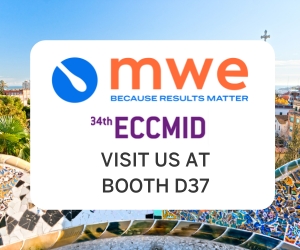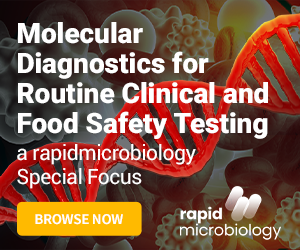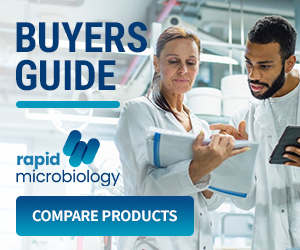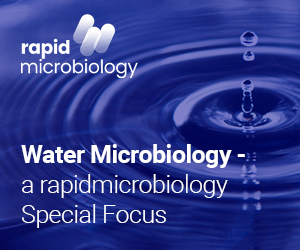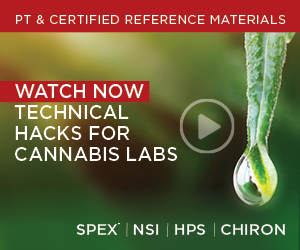| The OLRT detects Listeria species (with the exception of the non-pathogenic Listeria grayi subsp. grayi and subsp.murrayi), it is not species specific. Therefore, it is a good indicator test for final product, raw material and environmental testing. This will be a useful addition to HACCP plans.
For more information contact Carlene Simmons, Thermo Scientific
Tel: +44 (0) 1256 841144
Fax: +44 (0)1256 329728
Email: leslie.bissell@thermofisher.com
Web: www.oxoid.com
Product Description
Enrichment Broth System - Culture of the test sample is in two sequential enrichments, each of 24 hours. Any Listeria organisms present in the sample are selectively enriched using growth conditions which are optimal for flagella expression.
Antigen Extraction - The second enrichment media is heated at 80°C in a water bath, for 20 minutes to extract the antigen.
Listeria Device - Blue latex particles contained within the Listeria device are sensitized with specific monoclonal antibodies to the B flagella antigen 2 that is common to Listeria species. 135 µl of sample is taken from the upper quarter of the heated test sample and added to the pad in the Sample Window at the bottom of the device. The sample and sensitized latex particles migrate along the test strip by capillary action. A line of immobilised Listeria specific monoclonal antibodies is situated under the Results Window. If the sample contains antigen, latex-antigen complexes form and are then trapped by the immobilised monoclonal antibodies, forming a clearly visible blue line; this indicates a positive result. If the B flagella antigen is not present, complexes do not form and a line does not appear. Excess, unbound latex will flow past the Results Window and is trapped by a non-specific antibody in the Control Window. This acts as an integral control feature, with a blue line forming to show that the test has been carried out correctly.
Many methods for analysis of food are complex and time consuming. Listeria testing generally consists of two consecutive 24 hour selective enrichment broth cultures. The second broth is subcultured onto selective or diagnostic agar to distinguish presumptive Listeria colonies. These are then confirmed using biochemical tests. Total time to identification can take up to 7 days. Even a negative result can take over 96 hours. Using the Thermo Scientific Listeria Rapid Test method, which uses two 21 hour enrichments, a negative result can be achieved in as little as 43 hours. A presumptive positive result from the OLRT is also achieved in 43 hours which can be confirmed using further biochemical tests.
Background to Listeria
Listeria is a genus of Gram positive, non-sporing bacilli with a DNA G+C content of 36-38%. They have up to 6 peritrichous flagella and are motile when grown at 30°C or below. They are aerobic and facultatively anaerobic, catalase positive and oxidase negative. The genus comprises six species, L. monocytogenes, L. ivanovii, L. innocua, L. welshimeri, L. seeligeri and L. grayi subsp. Grayi and L. Grayi subsp. murrayi. All Listeria, except L. grayi, variously share 4 flagella antigens A, B, C, and D, of which flagella antigen B is common.3
Pathogenic and non-pathogenic Listeria are ubiquitous in nature and can be isolated from soil, vegetables and natural waters as well as from healthy animals and man. They are able to grow over a temperature range of 1-45°C. Consequently, L. monocytogenes is a food poisoning risk to susceptible individuals. Clinical symptoms include flu-like illness, spontaneous abortion, still birth, meningitis, pneumonitis, septicaemia and endocarditis. Listeria monocytogenes infections mainly occur in neonates, pregnant women, the elderly and immunocompromised individuals.4
Listeria monocytogenes human cases 1983 - 2001 in residents of England and Wales5 | | Non pregnancy- associated | Pregnancy- associated * | Not Known | TOTAL | | 1983 | 67 | 44 | - | 111 | | 1984 | 77 | 35 | - | 112 | | 1985 | 77 | 59 | - | 136 | | 1986 | 87 | 42 | - | 129 | | 1987 | 136 | 102 | - | 238 | | 1988 | 164 | 114 | - | 278 | | 1989 | 123 | 114 | - | 237 | | 1990 | 93 | 26 | - | 119 | | 1991 | 97 | 32 | - | 129 | | 1992 | 83 | 25 | - | 108 | | 1993 | 87 | 20 | - | 107 | | 1994 | 90 | 26 | - | 116 | | 1995 | 81 | 10 | - | 91 | | 1996 | 101 | 18 | - | 119 | | 1997 | 103 | 24 | - | 127 | | 1998 | 88 | 21 | - | 109 | | 1999 | 88 | 18 | - | 106 | | 2000 | 87 | 13 | - | 100 | | 2001 | 112 | 17 | 7 | 136 | Note: * a single pregnancy-associated case includes both mother and neonate.
References
1 CDR Weekly, News, 30 May 2003
2 Parry S.H., Briggs T., Blades J.A., Gani M & Piron J. (1993) A rapid Clearview Immunoassay for detection of Listeria. 7th. International Congress on Rapid Methods and Automation in Microbiology and Immunology.
3 Seeliger H.P.R. and Jones D. Genus Listeria Pirie. In: Sneath P.H.A., Mair H.S., Sharp N.E. and Holt J.G. (Eds): Bergey's Manual of Systematic Bacteriology. William & Wilkin Co. Baltimore, 1986.
4 www.cfsan.fda.gov Bad Bug Book
5 Laboratory Reports to CDSC; PHLS Food Hygiene Laboratory
|


